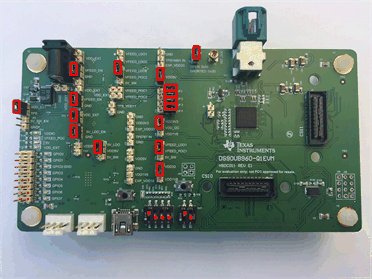SNLU226B February 2018 – April 2021 DS90UB960-Q1
- 1 Introduction
- 2 Features
- 3 Application Diagram
- 4 Major Components
- 5 Quick Start Guide
- 6 Board Connections
- 7 Enable and Reset
- 8 ALP Software Setup
- 9 Troubleshooting ALP Software
- 10Typical Connection and Test Equipment
- 11Termination Device
- 12Typical Test Setup
- 13Equipment References
- 14Cable References
- 15Bill of Materials
- 16PCB Schematics
- 17Board Layout
- 18Revision History
5 Quick Start Guide
- Ensure all jumpers and switches are placed and configured as shown in Figure 5-1
 Figure 5-1 DS90UB960-Q1EVM Jumper and Switch Configuration
Figure 5-1 DS90UB960-Q1EVM Jumper and Switch Configuration - Connect mini USB J37 to USB port for register programming
- Optional: Connect an external I2C host adapter I2C signals on J9 port for register programming
- Connect DS90UB953-Q1EVM boards or camera modules to one of the channels on CN1 using Quad Mini-Fakra to 4x Single Fakra cable assembly
- Optional: Interface MIPI CSI-2 output signals (J1 or J3) to application processor
- Provide power to the board. TI recommends using current limited bench supply to provide power to J30 (barrel jack) or J26 (+12VDC)
- Optional +1.1VDC power supply on J28
- Optional +1.8VDC power supply on J34
- Optional +3.3VDC power supply on J35
- Open Analog LaunchPAD. See Section 8 for details on installing and using Analog LaunchPAD.